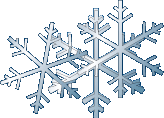Pristine Crystals
Ice crystals are hexagonal or six-sided because of the way water molecules bond to each other when they freeze. The temperature at which snow crystals form and to a lesser extent the humidity of the air determine their different shapes. Many natural crystals are a combination of shapes because they spend time in areas with different temperatures as they are carried higher by updrafts or fall through the cloud. They are also affected by such things as collisions, partial melting and riming. Snowflakes are collections of crystals that are held together by melting as they fall into warmer air.
 |
 |
 |
 |
 |
THIN PLATES |
NEEDLES |
HOLLOW COLUMNS |
SECTOR PLATES |
DENDRITES |
Return to WINTER WEATHER BASICS